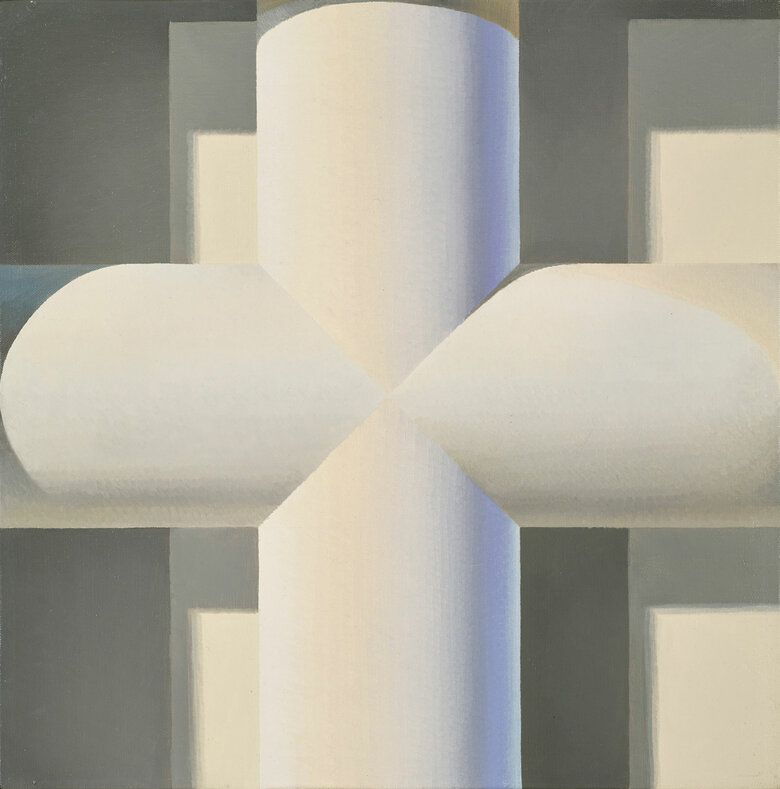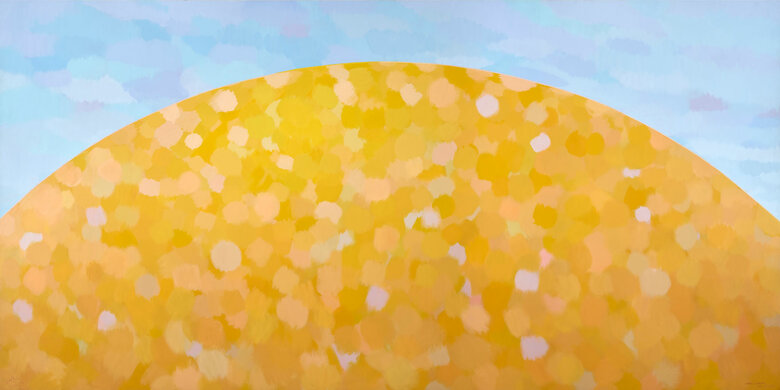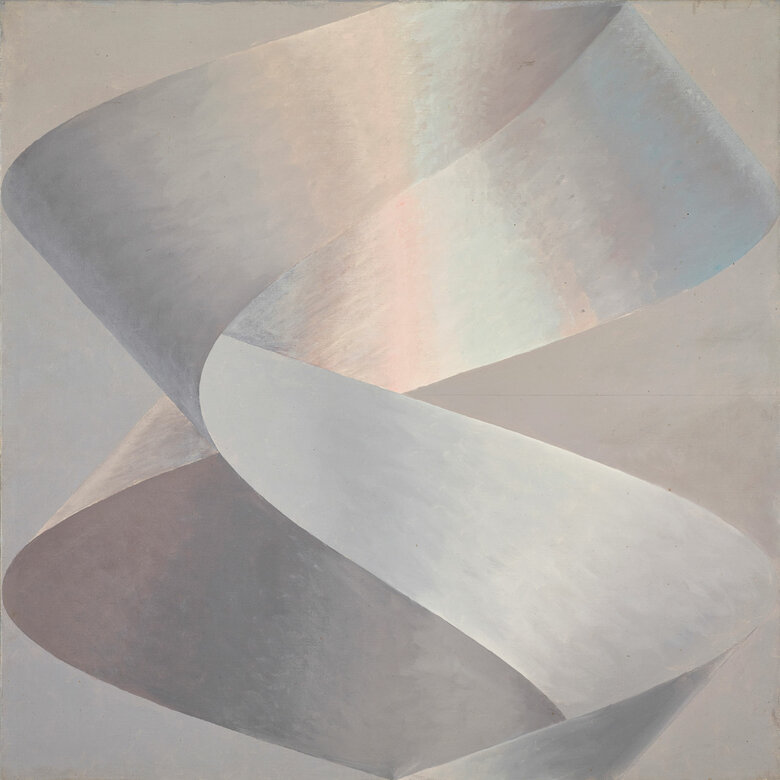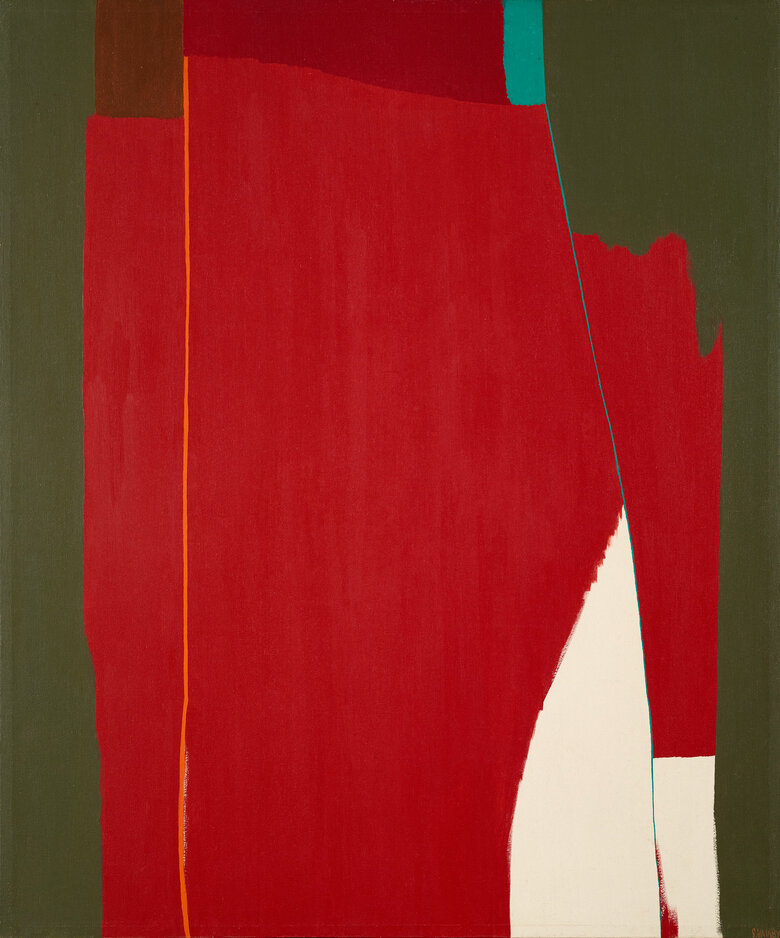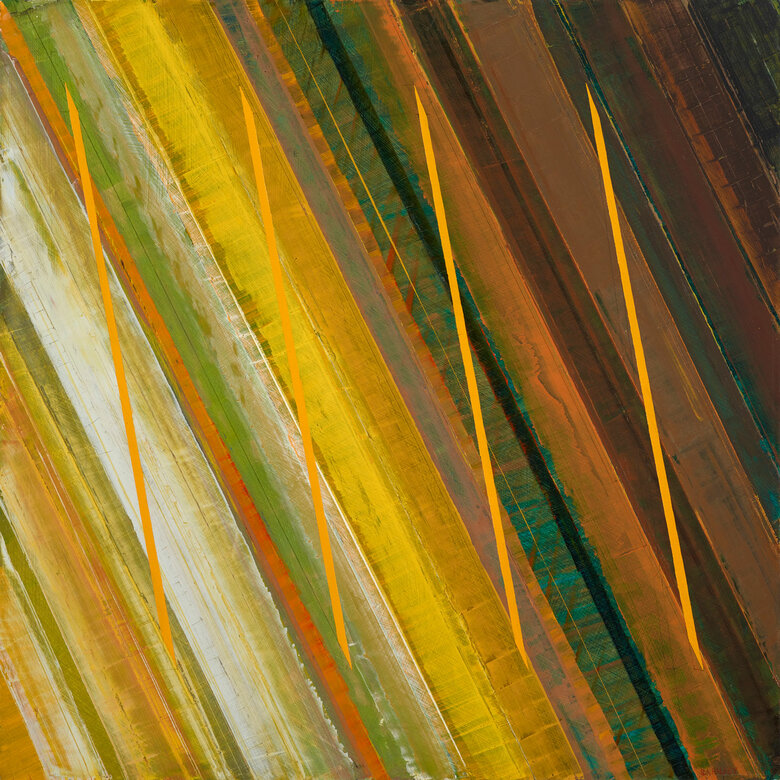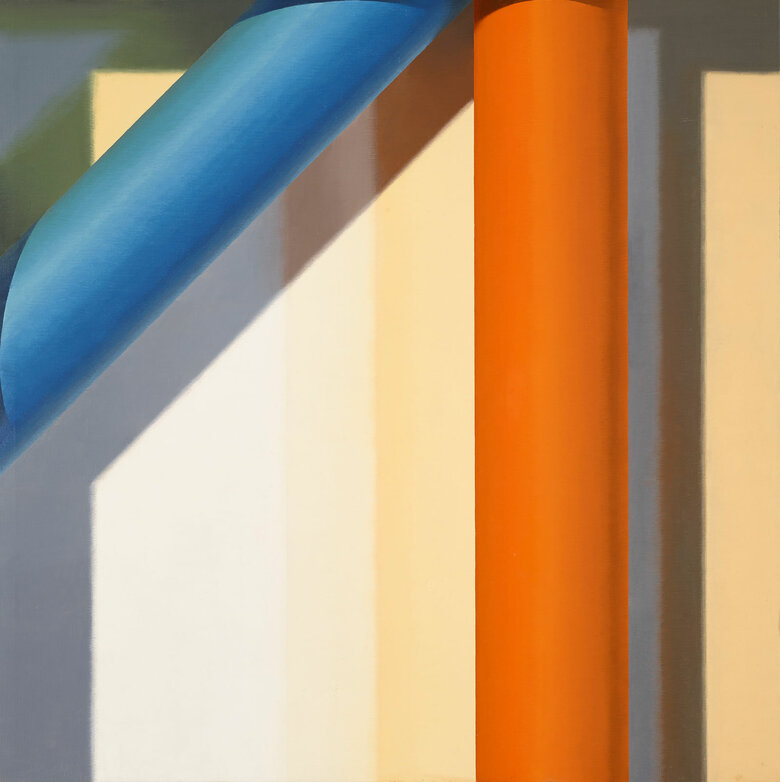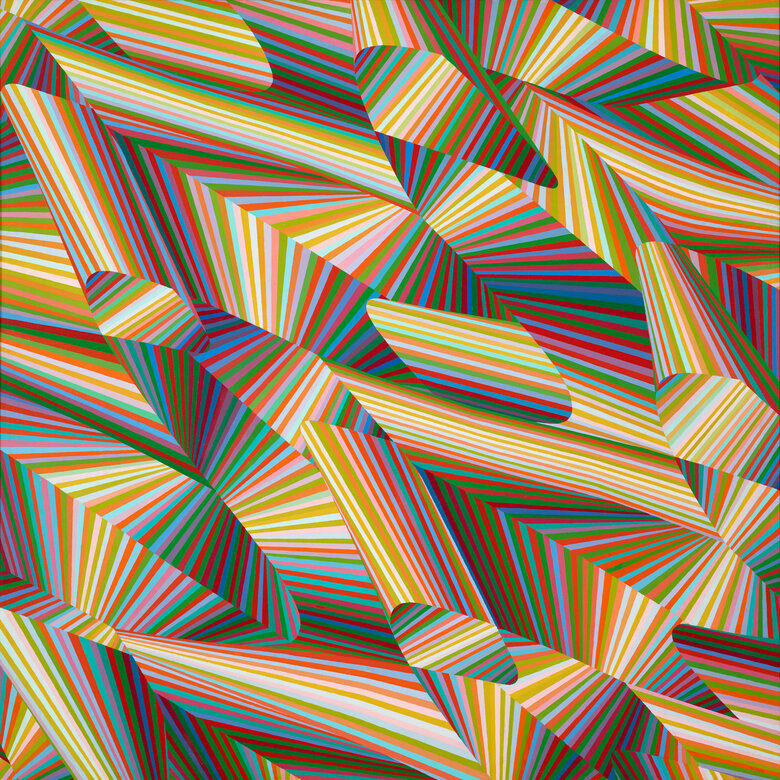A leading abstract visual artist, Samia Halaby, was born in 1936, in Jerusalem, Palestine. Halaby and her family relocated to Lebanon during the Nakba, Palestinian exodus in 1948. By then, most of...
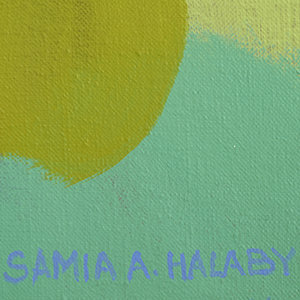

SAMIA HALABY, Palestine (1936)
Bio
Written by Wafa Roz
A leading abstract visual artist, Samia Halaby, was born in 1936, in Jerusalem, Palestine. Halaby and her family relocated to Lebanon during the Nakba, Palestinian exodus in 1948. By then, most of the Palestinian land was occupied, and the Israeli state was declared. The family soon settled in the United States in the early 1950s, where Samia completed her higher education. She obtained a BS in design, from University of Cincinnati, Cincinnati, Ohio, USA, in 1959, an MA in painting from Michigan State University, Ann Arbor, Michigan, the USA in 1960, and an MFA in painting too at Indiana University, Bloomington, Indiana, the USA in 1963. Following her graduation, Halaby taught at the University of Hawaii for one year and at the Kansas City Art Institute for two years, where she established a new studio art program. In 1971 she was recruited by Yale University to implement that same program. Halaby taught at the Yale School of Art from 1971 until 1982 and was the first full-time female associate professor in the department's history.
Through her extensive oeuvre, Halaby has explored, investigated, and pushed the notion of abstraction forward. In doing so, her approach has been analytical and intellectual. Halaby's enthralling abstract art thrives, not spirituality, nor does it voice the artist's personal or political stance. It summons her visual understanding of the world based on scientific grounds.
While teaching at the Kansas City Art Institute, Halaby was offered a grant to study historic architectural landmarks in the Middle East; the area is home to significant Islamic architecture and heritage sites. She visited Turkey, Egypt, Syria, and Palestine, learning the marvels of Islamic art and its abstract representational traditions. Visiting the Dome of the Rock in Jerusalem, she examined the polychromatic mosaics, geometric marble motifs, and patterned ceramic tiles that adorn its interior and external walls. This study informed much of her work later.
Similarly, Halaby's work is informed by Western abstract art learned during her college years. The Russian avant-garde art movements such as Suprematism and Constructivism inspired her. These movements initially evolved from European cubism and futurism. Of the artists who belonged to these movements, she admired most Kazimir Malevich, Olga Rosanova, and Lyubov Popova. Equally, Halaby was influenced by the German Bauhaus school, which was in tandem with the constructivists' ideals. Both emphasized design and knowledge of materials, bringing craftwork and industrial design closer to the realm of fine arts. American abstract expressionism left a mark on her too. Still, she was not concerned with gestural action painting practiced by most abstract expressionist artists, but surely, she was enthused by their revolutionary advance.
The two decades spanning from 1960 to 1980 were foundational in Halaby's artistic development. She arrived at the formal and conceptual bases of her celebrated aesthetic. In the early 1960's she produced color field paintings driven by the works of Mark Rothko, Ad Reinhardt, and surely the master of color Joseph Albers whose book Interaction of Color she had imbued herself with during her academic years. The illusion of space mostly took Halaby, and the distribution of color fields pertained to Rothko's paintings. Later, in the mid-1960s, she made a considerable shift and began a series of mid-sized geometric still life paintings. To create these works, Halaby modeled her geometric objects like spheres, cones, cylinders, and hollowed out rectangular cuboids. She arranged her objects the way she desired under various lights to analyze the effect of shade and shadow.
In progress, Halaby probed into the physical properties of materials and how they reflect under the light. She noticed that the specular highlight color of metallic objects differs from that of nonmetallic ones. For instance, the artist pinpointed that gold shines most because of its yellow highlight, unlike the dull white highlight characteristic of nonmetallic objects. Halaby painted spheres with dramatic shadows, cylinders with colored shadings, and intertwined conical helixes in metallic renderings. The reflection of light glowed in her works, especially those depicting silver-gray stainless steel. To accomplish the effect of depth and volume, Halaby manipulated her shadings and saturation of color.
Some of her distinctive paintings of this period, which are part of a series include White Cross, 1969, and Black Cross, 1969. Executed with supreme precision, both feature a duet of vertical and horizontal cylinders intersecting at the center of the painting. They dominate the surface of a 46x46cm square canvas. While the white cross is painted white, the black cross is toned in dark bronze and set against a mystic blue background. Iconic and shimmering as they seem, they insinuate to the Christian cross.
Halaby is an artist who has engaged in and embraced new technology. In the mid-1980s, she wrote a C-language based program on an Amiga computer to generate digital abstract paintings. Soon after, she designed kinetic computer paintings linked with emitting musical sounds. Melding the visual and audible in one, Halaby held Kinetic Art performances in collaboration with a group of musicians. On a large screen, Halaby's dynamic combinations of traversing lines, intricate shapes and vivid colors moved to the sound of music. Flat and frontal, the joggling image mirrored a multidimensional world.
In her mature stage, Halaby tackled large scale canvases. Her mid-sized painting, a window into the world, transformed into an open-ended one ready to receive the viewer into its space. Her first large-scale painting measuring 214 x 457 cm was Centers Of Attraction completed in 1989. It accumulates densely layered interlocking shapes, mostly colored with tints and tones of green, red, yellow, blue, and black acrylic paint. Halaby's formations initiate from basic shapes. Following Centers of Attraction, Halaby began registering endless possibilities of growing shapes on little sketchbooks, which in turn gave birth to several outstanding paintings. In her sketches, curved and straight linear projections intervene with circles, triangles, and squares to generate new forms and demand separate fields of color. As they multiply, twist, attract, and repel, the picture matures. The idea of growth lingered in Halaby's mind when she first observed the pattern formation on the surface of an autumn leaf. That was in 1983 during her many walks in the city of New York, a place she has inhabited since 1972. Whether walking in nature or by the beach, Halaby focuses "on the apparent compression and expansion of surfaces relative to the rhythm of movement," as the artist explains.
Liberated from the constraints of her otherwise absorbed learnings, Halaby based her work at a later stage on intuitive knowledge. She drew inspiration from her physical surroundings observing urban cityscapes. For instance, "trees in the city and how they look at night in artificial light" fascinate her. The view from the window of her apartment in New York feeds her imagination too. Halaby loads her city paintings with depth; she uses a diving view to represent her buildings and reduces them into simple hard-edged squares or rectangles painted in bold colors. Often segmented or interrupted at the periphery of her canvas, the artist sets her buildings in different structural compositions. Again, it's Halaby's interplay between color, light, shape, and size that gives an illusion of depth, whether from a bird's eye view or of an ant's eye view perspective. In Lemon Tree, 2011, for instance, tree leaves formed with oval brush strokes in yellow, orange, pink, and blue scatter in the center of the painting seemingly overlooked from surrounding sharp-edged buildings. Other urban compositions are based on what she calls "man's simple geometry." For example, in a small gouache on paper painting, Parade,1996, a diagonal stretch of blue rhombi with red round masses of paint allude to a circus parade passing by the city while people represented in blue brush strokes gravitate towards it.
Pushing the boundaries further, Halaby transposed the two-dimensional surface of a stretched canvas into a three-dimensional one. In practice, she tore ready-painted canvases into rags of sea-weed-like dwindling pieces and pinned them onto a solid background. Organically assembled, they curl, suspend, overlap, and expand setting free from the quadrilateral frame. Once more, Halaby reaches for endless options.
In her latest works, Halaby's vibrant shapes and overworked compositions transformed into bursts of color. In Rebirth of Palestine, 2014, acrylic on canvas painting measuring 200x 401cm, large dot-like patches spread along its horizontal surface. From right to left, they range from yellow-green, pale, and navy blue, to orange-red. They disperse like particles in a scattering sky when the color of the atmosphere changes towards sunset or at sunrise. As an Arab native, Halaby registers the 'rise and fall' from right to left the same way the Arabic language is written and read. Her work resonates with the repetitive patches in impressionistic paintings and the colorful gardens of Giverny painted by the leader of the movement, Claude Monet, whom Halaby cherishes.
Although Halaby distances her abstract art from politics, As a Palestinian living in exile and a leftist herself, Halaby is in opposition to all forms of repression and segregation. She documented Palestinian revolution art in her book Liberation Art of Palestine, 2001. Halaby based this work on thorough interviews she had organized with Palestinian artists in the occupied territories.
A progressive and inspirational artist, and a scholar of Palestinian art, Samia Halaby Lives and works in New York, USA.
Sources
Arjan. “Liberation Art of Palestine.” The Electronic Intifada, February 12, 2017. https://electronicintifada.net/content/liberation-art-palestine/5235.
Arte Fuse. “Interview with Artist Samia Halaby.” Arte Fuse, February 23, 2018. https://artefuse.com/2018/02/21/interview-with-artist-samia-halaby-125384/.
Exhibit-E.com. “Samia Halaby.” Ayyam Gallery. Accessed April 16, 2020. http://www.ayyamgallery.com/artists/samia-halaby/.
Farhat, Maymanah. “Illuminated Space: In the Studio with Samia Halaby, Harper's Bazaar Art Arabia, Spring 2017.” Academia.edu. Accessed April 16, 2020.
“From Palestine to New York and Back Again: On the Life and Work of Samia Halaby.” Arab America, May 3, 2019. https://www.arabamerica.com/from-palestine-to-new-york-and-back-again-on-the-life-and-work-of-samia-halaby/.
Halaby, Samia. “Samia Halaby: Five Decades of Painting and Innovation.” Amazon. Ayyam Gallery, 2010. https://www.amazon.com/Samia-Halaby-Decades-Painting-Innovation/dp/1861543425.
Halaby, Samia. “Growing Shapes: Aesthetic Insights of an Abstract Painter: Sketchbooks, Photographs, Essays, Notes.” Amazon. Palestine Books, Inc. in collaboration with Ayyam Gallery, 2016. https://www.amazon.com/Growing-Shapes-Aesthetic-Insights-Abstract/dp/0997263555.
Ink, Social. “Artist Spotlight: Samia Halaby.” Grey Art Gallery, March 19, 2020. https://greyartgallery.nyu.edu/2020/03/artist-spotlight-samia-halaby/.
Jadaliyya. “The Science of Form: An Interview with Samia Halaby.” Jadaliyya. Jadaliyya, July 10, 2017. https://www.jadaliyya.com/Details/33047.
“Kinetic Computer Paintings.” [Art on the Net]. Accessed April 16, 2020. http://www.art.net/~samia/kinetic/group/kinsub.html.
posts, Tanya All author, and Name *. “Seeking Samia Halaby.” My Olive Roots, August 29, 2018. http://myoliveroots.org/arts/seeking-samia-halaby/.
“Samia Halaby Archives.” Vogue Arabia. Accessed April 16, 2020. https://en.vogue.me/tags/samia-halaby/.
“Samia Halaby: Drawings of the Kafr Qasem Massacre.” Museum, February 22, 2017. http://museum.birzeit.edu/exhibitions/samia-halabydrawings-kafr-qasem-massacre.
Video
Artist Talk: Samia Halaby
https://www.youtube.com/watch?v=xwW4st-VivM
Samia Halaby
https://www.youtube.com/watch?v=nNx2jJWwu1k
Samia Halaby discussing her work at Ayyam Gallery London, 2013
https://www.youtube.com/watch?v=_q3XH8j92Bs
CV
Selected Solo Exhibitions
2024
Samia Halaby: Fragments of time, Sfeir-Semler Gallery, Hamburg, Germany
Samia Halaby: Eye Witness, Eli & Edythe Broad Art Museum at Michigan State University, Michigan, USA
2023
Samia Halaby: De-coding colors, Sfeir-Semler Gallery, Beirut, Karantina, Lebanon
Lasting Impressions: Samia Halaby, Sharjah Art Museum, Sharjah, United Arab Emirates
Samia Halaby: Retrospective: Lasting Impressions, Ayyam Gallery Dubai, Al Quoz, Dubai, United Arab Emirates
2021
Samia Halaby: Flurrying, Ayyam Gallery Dubai, Al Quoz, Dubai, United Arab Emirates
2019
Simple Complexity, Art Dubai, Ayyam Gallery Booth,Madinat Jumeirah,Dubai,UAE
2018
Opacity and Transparency, Ayyam Gallery, Beirut, Lebanon
Opacity and Transparency, Ayyam Gallery, Dubai, United Arab Emirates
2017
Illuminated Space, Ayyam Gallery, Al Quoz, Dubai, UAE
Documentary Drawings of the Kafr Qasem Massacre, Ayyam Gallery, Al Quoz, Dubai, UAE
Illuminated Space, Birzeit University Museum, Ramallah, Palestine
Documentary Drawings of the Kafr Qasem Massacre, Birzeit University Museum, Ramallah, Palestine
2015
Paintings from the Sixties and Seventies, Ayyam Gallery, London, UK
Five Decades of Painting and Innovation, Beirut Exhibition Center, Beirut, Lebanon
2014
Five Decades of Painting and Innovation, Ayyam Gallery, DIFC, Dubai, UAE
2013
New Paintings, Ayyam Gallery, London, UK
2011
Trees and The High Rising City, Ayyam Gallery, DIFC, Dubai, UAE
2010
Dance On Canal, Ayyam Gallery, Beirut, Lebanon
2009
Ayyam Gallery, Dubai, UAE
2008
Ayyam Gallery, Damascus, Syria
2006
A Useful Magnificent Language: The Work of Samia A. Halaby,Tompkins County Public Library, Ithaca, New York, USA
2004
Agial Gallery, Beirut, Lebanon
2001
Artim Gallery, Strasbourg, France
2000
Skoto Gallery, New York, USA
Sakakini Art Center, Ramallah, West Bank, Palestine
1999
Agial Gallery, Beirut, Lebanon
1997
Galerie Atassi, Damascus, Syria
1995
Darat Al Funun, Amman, Jordan
1988
Tossan-Tossan Gallery, New York, USA
1986
Galleria Palace de Arte, Granada, Spain
1983
Housatonic Museum, Bridgeport, Connecticut, USA, Tossan-Tossan Gallery, New York, USA
1978
Marilyn Pearl Gallery, New York, USA
1972
Yale University Art Gallery, New Haven, Connecticut, USA
1971
Phyllis Kind Gallery, Chicago, Illinois, USA
Selected Group Exhibitions
2025
Radical Software: Women, Art & Computing 1960–1991, Kunsthalle Wien, Museumsquartier, Vienna, Austria
2024
From Palestine with Art, P21 Gallery, Fitzrovia, London, United Kingdom
Small World Cinema, SculptureCenter, Long Island City, New York, USA
Radical Software: Women, Art & Computing, Madame Luxembourg, Musee d'Art Moderne Grand-Duc Jean, Luxembourg, Luxembourg
Foreigners Everywhere, 60th Venice Biennale, Venice, Italy
Prints and Printmaking, Dalloul Art Foundation, Beirut, Lebanon
Electric Dreams: Art And Technology Before The Internet, Tate Modern Bankside, London, UK
Art of Palestine: from the river to the sea, P21 Gallery, Fitzrovia, London, UK
2023
Untitled Abstractions, Dalloul Art Foundation (DAF), Beirut, Lebanon
Grounding Light, Manar Abu Dhabi, Abu Dhabi, UAE
Small World, Taipei Biennial, Taipei, Taiwan
2022
Selected Works On Paper: In the Footseps of Cai Lun II, Ayyam Gallery, Al Quoz, Dubai, UAE
Alle Tiders Mirakel/The Miracle of All Time, Kunsthall Oslo, Oslo, Norway
Taking Shape: Abstraction from the Arab World, 1950s-1980s, The Block Museum, Evanston, Chicago, Illinois, US
Natasha, Singapore Biennale 2022, Singapore
2021
Zaat: Collectors Eye, Fann A Porter, Dubai, UAE
Cities Under Quarantine: The Mailbox Project, Villa Romana, Florence, Italy
Postcolonial Ecologies, Darat al Funun, Amman Jordan
What Looms Large, Maed Art Museum, Amherst College, Massachusetts, USA
Leads & Artistic Cues from the Arab World, Dalloul Art Foundation (DAF), Beirut, Lebanon
2020
Taking Shape: Abstraction from the Arab World,1950s-1980s, NYU Grey Art Gallery, New York, USA
Optical Impact, HoMa, Honolulu Museum of Art, Hawaii, USA
2019
Intimate Terrains: Representations of a Disappearing Landscape, Palestinian Museum, Birzeit, Palestine
Grand Opening, Palestine Museum, Woodbridge, Connecticut, USA
Between two rounds of fire, the exile of the sea, Katzen Art Center, American University Museum, Washington DC, USA
Jerusalem Lives (Tahya Al Quds), The Palestinian Museum, Birzeit, Palestine
Enfolding and Unfolding: Geometric Abstraction in Motion, School of Visual Arts, New York, USA
2018
Abu Dhabi Art,Manarat Al Saadiyat Island,Abu Dhabi,UAE
Grand Opening, Palestine Museum, Woodbridge, Connecticut, USA
you + topia, Ayyam Gallery, Al Quoz, Dubai, UAE
2017
Abu Dhabi Art, Manarat Al Saadiyat Island, Abu Dhabi, UAE
Between two rounds of fire, the exile of the sea, Katzen Art Center, American University Museum, Washington DC, USA
In the Footsteps of Cai Lun: Selected Works on Paper, Ayyam Gallery, AlQuoz, Dubai, UAE
Jerusalem Lives (Tahya Al Quds), The Palestinian Museum, Birzeit,Palestine
Enfolding and Unfolding: Geometric Abstraction in Motion, School of Visual Arts, New York,USA
Künstlerinnen aus der Morgenland, Galerie Tanit, Munich, Germany
Painting Across Generation, Ayyam Gallery, DIFC, Dubai, UAE
2016
1970s: Women and Abstraction, Zürcher Gallery, New York
This Sea is Mine, 3rd Qalandiya International Biennial, Palestine
2015
Rituals of Signs and Transitions (1975 – 1995), Darat Al Funun, Amman, Jordan
Self: Portraits of Artists in Their Absence, National Academy Museum, New York, USA
2014
Seeing Through Light: Selections from the Guggenheim Abu Dhabi Collection, Guggenheim Abu Dhabi, Abu Dhabi, UAE
Contemporary Arabia, Ayyam Gallery, Jeddah, Saudi Arabia
Ultrapassado - Part 1 and Part II, Broadway 1602, New York City, New York, USA
2011
Selections from the Samawi Collection, Ayyam Gallery, Al Quoz, Dubai, UAE
2010
Then What? 1965-2010: The Samawi Collection, Ayyam Gallery, Damascus, Syria
2009
Feminin Pluriel (Female Plural), Area Gallery, Paris, France
Palestine: La création dans tous ses états (Palestine: Creativity in all its Generations), Institut du Monde Arabe, Paris, France
Perspectives: Arab & Iranian Modern Masters, Phillips de Pury & Company Gallery, London, UK
2007-08
Keep Hope Alive, The Olive Project, traveling exhibition: Ethnographic and Art Museum, Birzeit University, Palestine; Al Hoash Gallery, Jerusalem, Palestine; Japan Bank Building, Hiroshima, Japan; Maruki Gallery, Tokyo, Japan
2003
Made in Palestine, Station Museum of Contemporary Art, Houston, Texas,USA
Breaking the Veils, traveling exhibition: UNESCO, Paris, France; Rhodes, Greece; Athens, Greece (sponsored by the Jordan National Gallery of Fine Arts)
2001
Couleur Palestine (Rhythms from Palestine), Le musée du Château Dufresne, Montreal, Canada
1998
Palestinian Art, The Royal Academy of Art, Stockholm, Sweden
1994
Forces of Change, National Museum of Women, Washington D.C., USA
1991
Digitized and Manipulated, Sangre De Cristo Arts Center, Pueblo, Colorado,USA
Art And Algorithm, Minneapolis College of Art and Design, Minneapolis,USA
1990-91
Hilo International Exhibition Works on Paper, University of Hawaii, Hilo, USA
1989
Tercero Bienal de la Habana '89, Havana, Cuba
1985
TAMARIND: 25 Years 1960-1925, traveling exhibition: University Art Museum, University of New Mexico, Albuquerque, USA (under auspices of the Art Museum Association of America)
1983
Two-Artist Exhibition, Halaby and McClelland, 22 Wooster Gallery, New York, USA
1982
Palestinske Kunstnere (Palestinian Artists), Christiansands Kunstforening, Christiansands, Norway
1981
Palestinske Kunstnere (Palestinian Artists), Kunstnernes Hus, Oslo, Norway
1979
Contemporary Arab Artists II, Iraqi Cultural Center Gallery, London, UK
1977
Contemporary American Printmaking, Indiana University Art Museum, Bloomington, Indiana, USA
Group Show, Susan Caldwell Gallery, New York, USA
Contemporary American Prints, Utah Museum of Fine Arts, Salt Lake City, Utah, USA
1975
Tamarind Prints, National Gallery of Art, Washington D.C., USA
Recent Acquisitions, Solomon R. Guggenheim Museum, New York, USA
1974
Nine Connecticut Artists, The Wadsworth Athenaeum, Hartford, Connecticut, USA
1973
American Drawing, Yale University Art Gallery, New Haven, Connecticut, USA
1969-70
Six Faculty Artists, Indiana University Museum, Bloomington, Indiana, USA
1966-71
Art In The Embassies Program, Department of State & The National Gallery, Washington D.C., USA
1965
Art of Two Cities - Kansas City and Minneapolis (Purchase Award), traveling exhibition: Time-Life Gallery, New York, USA (sponsored by General Mills)
Performances - Kinetic Art
2000
Performance, Kinetic Painting Group, Skoto Gallery, New York, USA
1998
Performance, Kinetic Painting Group, The Williamsburg Art & Historical Center, Brooklyn, New York, USA
Performance, Kinetic Painting Group, Lincoln Center, New York, USA
1997
Performance, Kinetic Painting Group, Philadelphia College of Art, Philadelphia, USA
Performance, Kinetic Painting Group, Galerie Atassi, Damascus, Syria
Performance, Kinetic Painting Group, Galerie le Pont, Aleppo, Syria
Performance, Kinetic Painting Group, Darat Al Funun, Amman, Jordan
1994
Presentation, Small Computers in the Arts Network Conference, Philadelphia, USA
Performance, Kinetic Painting Group, Brooklyn Museum, Brooklyn, New York, USA
Presentation, Fifth International Symposium on Electronic Art, Philadelphia, Pennsylvania, USA
1993
Presentation, Fourth International Symposium on Electronic Art, Minneapolis, Minnesota, USA
Awards
2017
Creative Prize, Palestine Book Awards, London, England
2015
Madame Figaro’s 20 Most Powerful Women in the Middle East
2014
The World’s 100 Most Powerful Arab Women, Arabian Business
Collections
Ramzi and Saeda Dalloul Art Foundation (DAF), Beirut, Lebanon
Barjeel Art Foundation, Sharjah, UAE
Mathaf: Arab Museum of Modern Art, Doha, Qatar
The National Museum of Jordan, Amman, Jordan
Darat Al Funun - The Khalid Shoman Foundation, Amman, Jordan
Institut du Monde Arabe, Paris, France
The British Museum, London, UK
Alternative Museum, New York, USA
The Art Institute of Chicago, Chicago, Illinois, USA
Detroit Institute of Art, Detroit, Michigan, USA
Center for the Arts, Vero Beach, Florida, USA
Cincinnati Art Museum, Cincinnati, Ohio, USA
Cleveland Museum of Art, Cleveland, Ohio, USA
Fine Arts Museum of Long Island, Hempstead, New York, USA
Fort Wayne Museum of Art, Fort Wayne, Indiana, USA
The Guggenheim Museum, New York, USA
Honolulu Academy of Arts, Honolulu, Hawaii
Indiana University Museum, Bloomington, Indiana, USA
Indianapolis Museum of Art, Indianapolis, Indiana, USA
Kalamazoo Institute of Art, Kalamazoo, Michigan, USA
Mead Art Museum, Amherst, Massachusetts, USA
Memphis State University Art Collection, Tennessee, USA
Michigan State University Museum, East Lansing, Michigan, USA
The National Gallery of Art, Washington D.C., USA
The National Museum of Women in the Arts, Washington D.C., USA
Nelson Rockhill Gallery of Art, Kansas City, Missouri, USA
Palm Springs Desert Museum, Palm Springs, California, USA
Sioux City Art Center, Sioux City, Iowa, USA
Speed Art Museum, Louisville, Kentucky, USA
Tamarind Lithography Institute, Albuquerque, New Mexico, USA
The Jane Voorheese Immerli Art Museum, New Brunswick, New Jersey, USA
The University Gallery - Memphis State University, Memphis, Tennessee, USA
University of Michigan, Kalamazoo, Michigan, USA
Yale University Gallery, New Haven, Connecticut, USA
Writings by the Artist
2018
To Return Series, Institute for Palestine Studies, No. 116 [Autumn]
Ahmad Nawash, Painting in Exile, Jerusalem Quarterly no 76 [Winter]
2016
Growing Shapes: Aesthetic Insights of an Abstract Painter by Samia A. Halaby, Palestine Books, Emirates Printing Press (Dubai)
Drawing the Kafr Qasem Massacre by Samia A. Halaby, Schilt Publishing (Amsterdam, NL)
2015
Sophie Halaby, Jerusalem Quarterly [January]
The Pictorial Arts of Jerusalem 1900-1948, Jerusalem Interrupted Modernity and colonial Transformation 1917-Present, Edited by Lena Jayyusi, Interlink Publishing, Northampton, Massachusetts, USA, pages 21-56
2013
Homage to Leonardo, Jadaliyya [January 20]
Abed Abdi and the Liberation Art of Palestine, Jadaliyya [March 31]
Mustafa al-Hallaj: Master of the Print and Master of Ceremonies, Jadaliyya [May 31]
2005
The Subject of Palestine, DePaul university Museum catalogue [February-May]
2001
Liberation Art of Palestine: Palestinian Paintings and Sculpture in the Second Half of the 20th Century, H.T.T.B. Publishing, New York, USA
1993
Technology, Abstraction, and Kinetic Painting, (Fourth International Symposium onElectronic Art) FISEA PAPERS, pages 57-66
1989
On Art And Politics, Arab Studies Quarterly [winter/spring]
Pictures in Computer Medium, PROCEEDINGS of the 9th Small Computer in The Arts Network (SCAN) Conference, IEEE, pages 100-105
1988
Computer and Abstract Painting: The Monitor as Picture Plane, PROCEEDINGS of the 8th SCAN Conference, IEEE, pages 109-114
1987
Nature, Reality and Abstract Picturing, Leonardo, Volume 20, Issue 3, pages 225, 241-246
Monographs
2014
Samia Halaby: Five Decades of Painting and Innovation, Edited by Maymanah Farhat, Booth-Clibborn Editions, London, UK
2006
Samia Halaby, Fine Arts Publishing, Beirut, Lebanon (Authors: Inea Bushnaq and Samia Halaby)
Press
Indiana University Cancels Major Exhibition of Palestinian Artist
Zachary Small
www.nytimes.com, English, 2024
Samia Halaby, an 87-year-old artist, has been outspoken in her support of Palestinians during the Israel-Gaza war.
'We put up a good fight': Palestinian artist Samia Halaby responds to US show cancellation
Melissa Gronlund
www.thenationalnews.com, English, 2024
In an exclusive interview with The National, abstract painter says she detects 'sentiment shift' among younger Americans following occupied country's struggle
US museum under fire for cancelling Palestinian artist’s retrospective
www.theartnewspaper.com
www.theartnewspaper.com, English, 2024
The Eskenazi Museum of Art of the Indiana University in Bloomington cited “safety concerns” when it abruptly cancelled Samia Halaby’s show
Eskenazi School reputation is damaged after IU cancels Palestinian artist, letter says
Aubrey Wright
www.indianapublicmedia.org, English, 2024
Samia Halaby celebrated in Sharjah with first retrospective in the Middle East
Razmig Bedirian
www.thenationalnews.com, English, 2023
Explorations of perception through diverse media have made the Palestinian artist a pioneer in the art world
Al Arab.pdf
An artist who dares to code: Palestinian painter Samia Halaby opens up about her pioneering digital work
Melissa Gronlund
The National, English, 2020
Artist Spotlight: Samia Halaby
Lara Arafeh
Grey Art Gallery NYU, English, 2020
Break Away: Samia Halaby on Late Work
Vogue Arabia
Vogue Arabia, English, 2017
Interview with Artist Samia Halaby
ARTEFUSE
ARTEFUSE, English, 2018
On "Liberation Art" and Revolutionary Aesthetics with Samia Halaby
Maymanah Farhat
Jadaliyya.com, English, 2012
Samia Halaby: Radical optimism in art and political commitment for Palestine
Naima Morelli
The New Arab, English, 2024
Samia Halaby — artist, activist and teacher
Arab News, English, 2014
“My art is based on political analysis”
Denise Marray
GULF TIMES, English, 2013
Abstraction is all about reality for artist Samia Halaby
Anna Seaman
The National News, English, 2014
A fresh look at the city: Veteran artist Samia Halaby takes on a new challenge in her abstract depictions of urbanity
Jyoti Kalsi
GULF NEWS, English, 2011
ArtintheCity speaks to artist Samia Halaby, currently on show in Ayyam Gallery, DIFC
Art in the City, English, 2011
SAMIA HALABY: TREES AND THE HIGH RISING CITY
ILLUMINATED SPACE: A visit to Samia Halaby’s studio in New York reveals the artist’s intimate works that currently make up Halaby’s current exhibition at Ayyam Gallery
Maymanah Farhat
Harpes Bazaar Arabia, English, 2017
Life comes full circle for Samia Halaby
Jyoti Kalsi
GulfNews.com, English, 2014
No Time for the Olive Branch: Profile on Samia Halaby
Tam Hussein
HuffPost UK, English, 2013
سامية حلبي_ العرب هم من اخترعوا التجريد - اكتشف سورية.pdf
In the studio with artist Samia Halaby_ Why she says painting 'isn't about her feelings' _ NCPR News.pdf
Outernet and Tate premiere new work by Samia Halaby with sound by Four Tet - Outernet London.pdf
Palestinian artist Samia Halaby exhibits work at 15th Havana Biennial _ Peoples Dispatch.pdf
Palestinian Artist Samia Halaby Had Her U.S. Museum Debut Abruptly Canceled. Now, She’s Focused on the Future.pdf
SAMIA HALABY Artwork
Become a Member
Join us in our endless discovery of modern and contemporary Arab art
Become a Member
Get updates from DAF
Follow Artists
Save your favourite Artworks
Share your perspectives on Artworks
Be part of our community
It's Free!
We value your privacy
TermsCookiesPrivacy Policies
Become a Member
Get updates from DAF
Follow Artists
Save your favourite Artworks
Share your perspectives on Artworks
Be part of our community
It's Free!
We value your privacy
TermsCookiesPrivacy Policies
Become a Member
Get updates from DAF
Follow Artists
Save your favourite Artworks
Share your perspectives on Artworks
Be part of our community
It's Free!
We value your privacy
TermsCookiesPrivacy Policies
Welcome to the Dalloul Art Foundation
Thank you for joining our community
If you have entered your email to become a member of the Dalloul Art Foundation, please click the button below to confirm your email and agree to our Terms, Cookie & Privacy policies.
We value your privacy, see how
Become a Member
Get updates from DAF
Follow Artists
Save your favourite Artworks
Share your perspectives on Artworks
Be part of our community
It's Free!
We value your privacy
TermsCookiesPrivacy Policies

-SamiaHalaby-Front.jpg)
-SamiaHalaby-Front.jpg)
